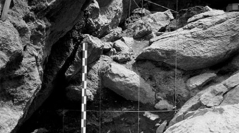

 Comptes Rendus Palevol
13 (7) - Pages 623-636
Comptes Rendus Palevol
13 (7) - Pages 623-636A series of 36 radiocarbon AMS ages produced from separate bone fragments has prompted a new appraisal of the archaeological sequence of the Rond-du-Barry Cave (Polignac, Haute-Loire). A huge rock-fall of unknown age underlies Unit H, which contains evidence of the oldest human occupation of the site consisting of a Middle Palaeolithic assemblage dated to between 40 and 33 kyr. The first Upper Palaeolithic occupation of the Cave occurred later. In Unit F, three Badegoulian occupation sectors can be identified that are dated to between 20 and 17.5 kyr. The uppermost units, E and D yielded Middle and Upper Magdalenian dates of between 15.4 and 12.4 kyr. Within Unit E, a tephra related layer (E6) is likely to belong to a distal southern lobe of an eruptive event that was centred in the Chaîne des Puys, 100 km to the north. Unit D shows evidence of being re-worked at least during Mesolithic/Neolithic times, circa 6.5/4.9 kyr. The sum of this new evidence demonstrates the existence of a previously unrecognised stratigraphic and spatial complexity within the Rond-du-Barry archaeological deposits, which demands that new investigations be made in this cave.
Radiocarbone, Spectrométrie de masse par accélérateur, Moustérien, Badegoulien, Magdalénien, Os, Bois de renne, Téphra